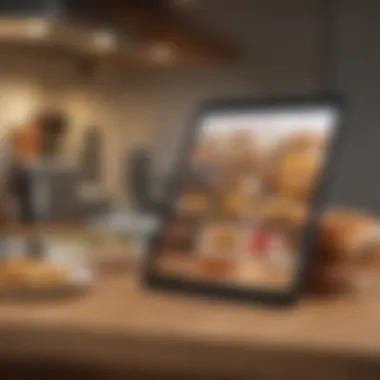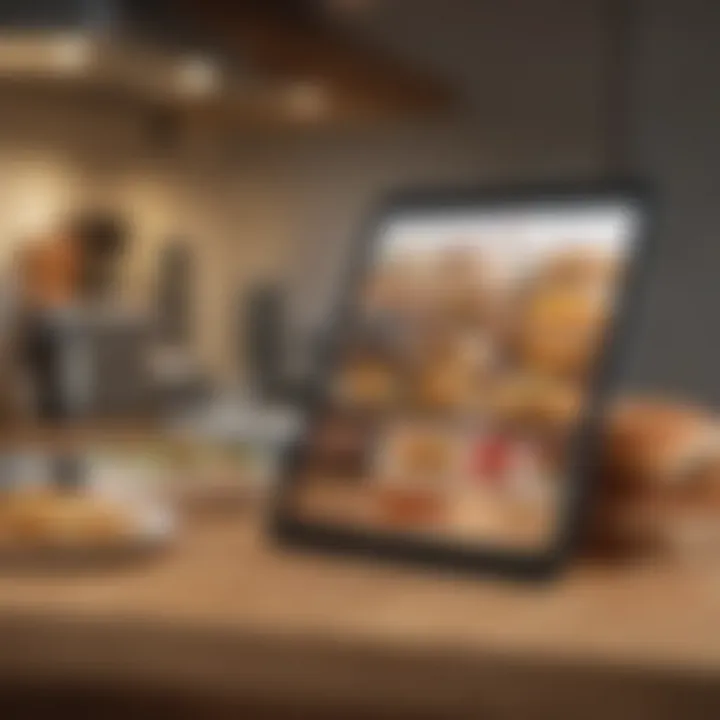Exploring the Modern Landscape of Food Delivery


Intro
The food delivery industry has seen remarkable transformations in recent years. While once limited to pizza and some takeout, the options have expanded dramatically. Today, consumers have access to a plethora of cuisines and meal choices delivered right to their doorstep. This evolution is driven not only by consumer demand but also by advancements in technology and changes in societal norms.
The shift towards convenience has reshaped how people view meals. Busy lifestyles often leave little time for cooking, leading many to rely on food delivery services. Furthermore, the increased awareness of health and wellness has prompted companies to innovate recipes that cater to these concerns. As a result, we witness a merging of culinary creativity and technology, providing experiences as diverse as the consumers themselves.
"The food delivery sector is a reflection of modern consumer culture, emphasizing convenience, variety, and health-conscious choices."
In this article, we will navigate through the key components of this landscape. We will explore operational frameworks, the role of technology in customer experience, the influence of health trends, and what the future may hold. By dissecting these elements, we aim to provide a comprehensive understanding of the complexities defining this space today.
Prelims to Food Prepared and Delivered
The shift toward food prepared and delivered marks a significant evolution in how people approach eating. This transformation underscores an increasingly busy lifestyle where convenience and efficiency take priority. Understanding this landscape is essential for various stakeholders, from consumers to food service providers. The benefits of food delivery services can be substantial, including time savings, access to diverse cuisines, and the ability to cater to specific dietary needs. As urbanization intensifies and technology becomes integral to daily life, the relevance of food delivery systems gains prominence.
The Evolution of Food Delivery Services
Food delivery has undergone notable changes over the decades. In the past, a limited selection of takeout options existed, typically offered by local diners and pizzerias. These services relied heavily on phone orders, creating barriers to efficiency and quality control. However, with the advent of the internet and mobile technology, the food delivery space began to diversify.
Modern food delivery services, including platforms like Uber Eats, DoorDash, and Grubhub, have revolutionized the landscape. They offer vast menus from an array of restaurants, allowing consumers to order directly from their mobile devices. This expansion not only democratizes food access but also supports local businesses by widening their customer base and increasing visibility. Delivery methods have also shifted from simple car deliveries to utilizing bicycles and drones to meet the growing demand swiftly.
Innovations have increased customer expectations, pushing providers to streamline operations continuously. Next-day delivery promises, contactless services, and real-time tracking are now standard practices that enhance the overall dining experience.
Current Market Dynamics
The current state of the food delivery market is characterized by intense competition and rapid growth. As of 2023, the industry has seen a significant spike in revenue, propelled by factors such as changes in consumer habits and urban lifestyles. More than ever, consumers are turning to food delivery services for their convenience and accessibility.
Several trends are shaping the market:
- Subscription Models: Many companies are adopting subscription-based services, providing customers with regular meal deliveries at better rates.
- Health Conscious Choices: There is a rise in demand for healthy meal options that cater to specific dietary preferences, reflecting a broader societal shift towards health and wellness.
- Hybrid Models: Restaurants are increasingly exploring hybrid formats that include both dine-in and delivery options. This approach allows them to maximize their revenue streams while meeting customer needs.
As consumer preferences evolve, food delivery services must adapt to maintain relevance. Those who innovate and respond to market demands will likely succeed in this competitive arena.
The evolution of food delivery services has not only changed how we access food but has also transformed dining culture, making diverse culinary options readily available at our fingertips.
Understanding Consumer Demand
Understanding consumer demand is essential to grasp the dynamics of the food delivery industry. Today, consumers have distinct preferences that influence their choices regarding meal preparation and delivery. Recognizing these demand trends allows businesses to adapt their services and cater effectively to various customer needs.
Shifts in Eating Habits
Contemporary eating habits reflect a profound shift driven by several factors. Firstly, the rise of health consciousness significantly impacts consumer choices. Many are prioritizing nutrition and balanced diets, leading to increased demand for wholesome, organic, or plant-based options. Moreover, the global pandemic has intensified the trend of home dining, with consumers now more inclined to explore home-delivered meals as part of their everyday life.
Social media also plays a role. Platforms like Instagram create trends by showcasing visually appealing food, leading to growing interest in diverse cuisines. People are increasingly willing to try flavors they might not have considered before, significantly influencing their ordering behavior.
The Role of Convenience
Convenience is perhaps the most critical element in driving consumer demand in the food delivery sector. Busy lifestyles drive individuals to seek out quick and efficient dining solutions. A significant portion of consumers often chooses delivery over home cooking due to time constraints, especially during weekdays.
Furthermore, technology enhances this convenience factor. With online ordering systems becoming more user-friendly, consumers can quickly browse menus, customize their meals, and complete transactions with ease. Mobile apps like Uber Eats and DoorDash simplify the process, allowing users to track deliveries in real-time.
"The key to successful food delivery lies not only in the meal but also in the overall experience of ease and comfort for the consumer."
The demand for convenience extends beyond just quick service. Many consumers appreciate bundled meal options or subscription services, where they can receive regular deliveries of prepackaged ingredients or ready-to-eat meals. This model not only accommodates their busy schedules but also aligns with desires for exploration and cooking without extensive prep time.


In summary, as consumer demand evolves, businesses in the food delivery sector must stay agile. Understanding shifts in eating habits and the growing necessity for convenience can provide valuable insights. Catering to these preferences fosters not only satisfaction but also loyalty among a diverse and discerning customer base.
The Operational Framework of Delivery Services
The operational framework of delivery services is fundamental in shaping how meals are prepared and brought to consumers. This framework encompasses various critical components, such as kitchen operations, logistics, and distribution. Understanding these elements allows stakeholders to optimize processes, enhance service delivery, and ultimately meet the demands of today’s consumers. A successful delivery service hinges on streamlined operations that ensure quality, speed, and consistency in meal experiences.
Kitchen Operations
Efficient kitchen operations are the backbone of any food delivery service. A well-organized kitchen ensures that meals are prepared in a timely manner while adhering to health and safety standards. Kitchens must be designed for workflow efficiency, enabling staff to move seamlessly between tasks. This may involve proper station setups, equipment placements, and ingredient accessibility. Additionally, implementing standardized recipes can help maintain consistency, a vital aspect for building customer trust and loyalty.
Important considerations in kitchen operations include:
- Staff Training: Well-trained staff can handle tools and ingredients efficiently. Training fosters an environment that prioritizes safety without sacrificing speed.
- Inventory Management: Keeping track of ingredients helps reduce waste and ensures that meals can be produced without delay. Utilizing software solutions can provide real-time inventory tracking.
- Meal Customization: Offering personalized options allows consumers to create meals that meet their specific dietary needs, which is becoming increasingly popular.
Logistics and Distribution
Logistics encompass the coordination of transporting food from kitchens to consumers. This is a complex process that requires careful planning and execution. Effective logistics ensure that food arrives fresh and within expected time frames, directly impacting customer satisfaction.
Key factors in logistics and distribution include:
- Delivery Networks: Building reliable networks of delivery personnel can enhance service reach. An extensive network allows services to respond quickly to orders and manage peak times efficiently.
- Technology Utilization: Modern delivery services leverage technology for route optimization. Using software analytics can significantly reduce delivery times and improve overall efficiency.
- Temperature Control: Ensuring that food maintains proper temperature during transport is essential for quality and safety. Packaging solutions that insulate and keep food at appropriate temperatures are crucial components of this process.
"The logistics of food delivery extends far beyond just transport; it incorporates everything from meal preparation to customer satisfaction."
Understanding the operational framework of delivery services is not only about identifying problems, but also about seizing opportunities for enhancement. As market demands evolve, companies must be adaptable. This leads to a more resilient and responsive food delivery industry.
Technology in Food Preparation and Delivery
In the modern food delivery landscape, technology serves as a pivotal foundation that transforms traditional eating experiences. Advances in technology have not just streamlined the logistics of meal distribution but have also improved the menu selection process for diners. It enhances operational efficiency and reshapes consumer engagement, making it an essential topic in this article. Various elements play crucial roles, including online ordering systems and mobile applications, both catering to the convenience-driven consumer.
Online Ordering Systems
Online ordering systems have reshaped how meals are selected and purchased. These systems allow consumers to browse menus, customize orders, and make payments seamlessly. The immediate benefits include saving time and offering a variety of options just a few clicks away. Businesses can leverage data analytics within these systems to track consumer preferences and purchase behavior. This ability can lead to personalized marketing strategies that connect more closely with the target audience.
Key features of online ordering systems include:
- User-friendly Interface: Intuitive designs attract users and facilitate easier navigation. Users can find what they need without confusion.
- Customization Options: Customers appreciate the ability to tailor orders to their dietary needs or preferences. This caters to diverse tastes and encourages repeat business.
- Payment Security: Reassuring consumers about the security of their payment information builds trust and encourages usage.
Adapting these systems demands ongoing updates to ensure functionality meets customer expectations.
Mobile Applications and User Experience
Mobile applications further enhance the food delivery experience with their accessibility. They allow customers to order meals from anywhere, making food delivery even more appealing. An effective mobile application emphasizes user experience through easy navigation, quick loading times, and responsiveness. These elements are vital in maintaining user engagement.
The significance of mobile applications can be highlighted by considering the following aspects:
- Real-time Tracking: Users can monitor their orders from preparation to delivery, adding a layer of transparency that builds consumer trust.
- Loyalty Programs: Many applications integrate loyalty rewards, encouraging more frequent purchases and fostering brand loyalty.
- Feedback Mechanism: By enabling reviews and feedback options directly in the app, businesses can quickly respond to customer concerns and preferences, continuously improving their offerings.
"Investing in technology is not just about operational efficiency; it's a way to forge deeper connections with consumers in an increasingly digital world."
Health and Dietary Trends
The convergence of health awareness and dietary preferences has defined the modern food delivery landscape. Consumers today are increasingly mindful of what they eat. The significance of this trend lies in its implications for food providers and delivery services. With a surge in dietary-specific demands, companies must adapt to meet consumer expectations for health, quality, and transparency.
Emerging Dietary Preferences


New dietary trends are constantly emerging, influenced by factors like health concerns, ethical considerations, and cultural shifts. For instance, veganism has gained traction, driven by concerns about animal welfare and environmental sustainability. Similarly, gluten-free and low-carb diets have entered the mainstream, appealing to those with dietary restrictions or specific health goals.
Key points include:
- The rise in plant-based eating choices among younger consumers.
- An increase in the popularity of meal plans catering to specific diets, such as paleo and keto.
- The importance of cultural diversity reflected in food preferences, leading to broader menus in delivery options.
Food service providers must be astute in recognizing these shifts to stay relevant. Whether they are launching new menus or tweaking existing offerings, understanding dietary preferences helps in capturing a diverse customer base.
Demand for Nutritional Information
As consumers become more health-conscious, there is a strong demand for nutritional information regarding meal options. Transparency has become paramount; people want to know not just the calorie count but also ingredient sourcing, allergens, and processing methods.
Consumers regard this information as a baseline for making informed choices.
Emerging practices include:
- Detailed menus that provide complete nutritional facts alongside each meal option.
- Use of symbols or labels to highlight dietary credibility, such as organic or non-GMO.
- Access to online resources that allow customers to track their dietary intake based on their purchases.
Food delivery services must incorporate these insights into their offerings. Assuring customers of the transparency in meals not only builds trust but also fosters brand loyalty in an increasingly competitive market.
"The most successful brands are those that attentively listen and adapt to the evolving health consciousness of their customers."
Challenges and Opportunities
The food delivery industry is at a critical juncture where challenges and opportunities coexist. Understanding this dynamic is essential for stakeholders looking to thrive in a competitive market. This section will delve into the prevailing issues, highlight the significance of addressing them, and examine the potential opportunities that arise from overcoming these hurdles.
Food Safety Concerns
Food safety has become a paramount concern in the meal preparation and delivery sector. Consumers today are increasingly discerning about the hygiene and safety standards of the food they consume. Several factors contribute to these concerns:
- Handling Practices: Proper food handling practices throughout the delivery process are critical. This includes maintaining appropriate temperatures during storage and transit to prevent foodborne illnesses.
- Packaging: Safe packaging plays a key role in minimizing contamination. Businesses are exploring innovative materials that are both eco-friendly and capable of preserving food quality.
- Regulatory Compliance: Adhering to local health regulations is vital. Restaurants must ensure that they are compliant with food safety standards. Regular training for staff about food safety protocols can help in maintaining high standards.
Addressing food safety concerns not only protects consumers but also enhances brand reputation. Businesses that prioritize safety can build trust with customers, leading to repeat business and positive reviews.
"In the end, effective food safety measures result in higher customer satisfaction and loyalty, essential for longevity in the competitive food delivery landscape."
Sustainability in Delivery Practices
Sustainability is increasingly becoming a focal point in the food delivery industry. As consumers become more conscious of their environmental footprint, companies must adapt to meet these expectations. Here are several key elements of sustainable delivery practices:
- Eco-Friendly Packaging: Many companies are shifting towards recyclable or biodegradable packaging options. This change not only reduces waste but also aligns with consumer values.
- Carbon Footprint Reduction: Delivery services are exploring routes and methods that optimize fuel efficiency and minimize emissions. Some are implementing electric vehicles or bicycles as an alternative to traditional delivery cars.
- Local Sourcing: Sourcing ingredients locally can dramatically reduce transportation emissions. This practice also supports local economies and fosters stronger community ties.
When businesses embrace sustainability, they often find new opportunities for differentiation. Customers are more inclined to support brands that demonstrate a commitment to environmental stewardship.
Moreover, implementing sustainable practices goes hand-in-hand with enhancing operational efficiencies and reducing costs over time.
By effectively addressing the challenges associated with food safety and sustainability, food delivery services can create a resilient framework that not only meets current demands but also positions them for future growth.
The Consumer Experience
The consumer experience is a pivotal aspect of the food prepared and delivered landscape. It encapsulates how customers interact with the food service, from the moment they consider ordering to when they receive their meals. As competition intensifies, businesses must prioritize creating a positive and memorable experience. A few key elements significantly contribute to enhancing the consumer experience in this sector.
First, the ease of online ordering is crucial. Customers appreciate streamlined platforms that allow them to place orders without hassle. Factors such as clear menus, easy navigation, and quick payment options can significantly improve satisfaction. Understanding customers' preferences also plays a vital role. Personalization in meal options, where customers can tailor their dishes according to dietary needs or taste preferences, enhances their involvement and satisfaction.
Next, prompt and reliable delivery is essential. Timely delivery impacts customer perceptions and can determine whether they will reorder from a specific service. Since consumers often seek convenience, failures in this area could result in lost trust and future business.


Finally, businesses must consider integrating feedback loops to continuously improve. Actively listening to customers' responses can aid in refining services and offerings.
Personalization of Meal Options
Personalization has become a significant trend among food delivery services. Consumers increasingly desire meals that cater to their specific tastes and dietary requirements. Such options empower customers to feel in control when choosing what they eat and allow them to customize their orders.
- Dietary Preferences: Many individuals require meals that accommodate specific dietary restrictions while still appealing to their tastes. Options for vegetarian, vegan, gluten-free, and low-carb choices are widely desired.
- Flavor Profiles: Allowing customization of flavor profiles—from spicy to mild—enables businesses to cater to diverse palates. This can be achieved through interactive features on apps or websites where customers can select their preferred ingredients or seasonings.
- Loyalty Programs: Incorporating loyalty benefits and personalized recommendations based on past orders enhances the user experience. These strategies foster a greater sense of connection between the consumer and the service.
Personalization not only builds brand loyalty, but enhances overall customer satisfaction.
Feedback and Reviews
Feedback and reviews are invaluable components of the consumer experience in food delivery services. They serve as a bridge between businesses and customers, giving insights into both parties’ perspectives. For consumers, reading reviews can significantly influence their decision-making process. Positive reviews can encourage potential customers to try a service, while negative feedback can steer them away.
- Building Credibility: Reviews build trust; consumers often rely on the experiences of others before making purchases. A strong presence of positive feedback on platforms such as Reddit or social media can enhance credibility and attract new customers.
- Quality Improvement: For businesses, feedback serves as a tool for improvement. Identifying frequent complaints helps entities address issues systematically. Positive feedback can highlight what customers enjoy, ensuring that these features are maintained and possibly enhanced.
In summary, fostering an environment where feedback is welcomed—not only on service and delivery speed but also on meal quality—can significantly enhance the overall consumer experience.
Future Trends in Food Delivery
The landscape of food delivery is continuously changing. Understanding future trends in this area is essential for stakeholders looking to stay ahead. These trends not only reflect consumer preferences but also the broader shifts in technology, sustainability, and market dynamics. In this section, we will consider the upcoming changes likely to shape the industry.
Technology Advancements
As technology evolves, so do the tools available for food delivery services. One significant advancement is the use of artificial intelligence (AI) in optimizing delivery routes. This minimizes delivery time and enhances efficiency, leading to a better customer experience. Companies like Uber Eats and DoorDash have started integrating AI algorithms into their systems for this purpose.
In addition, contactless delivery options have gained traction since the COVID-19 pandemic. The push for contactless solutions is likely to remain strong due to heightened awareness of hygiene. The development of drone delivery systems represents another major leap. Companies are testing drones to transport food from restaurants to consumers directly, which could significantly reduce delivery times in urban areas.
Moreover, smart kitchen appliances are emerging as valuable allies in meal prep. Devices connected to the internet can now help users monitor their cooking and even automate processes. This integration of technology simplifies meal preparation and aligns with the increasing demand for convenience.
Potential Market Innovations
Innovations in the food delivery market extend beyond technology; they also address changing consumer attitudes and preferences. Ghost kitchens, which are restaurants without a physical storefront, are becoming more popular. These establishments focus solely on preparing meals for delivery, leading to lower overhead costs. This change benefits consumers with diverse food options while allowing chefs to experiment freely without the constraints of a traditional dine-in setting.
In addition, meal subscription services are gaining ground. These services provide pre-packaged ingredients and recipes directly to the consumer. They not only promote cooking at home but also cut down on food waste, as ingredients are provided in precise portions. Brands like Blue Apron and HelloFresh have capitalized on this demand and continue to refine their offerings.
Furthermore, there is a notable interest in local sourcing. Consumers are increasingly concerned about where their food comes from. Services that highlight sourcing, such as locally produced ingredients, resonate well with conscious eaters. Companies adopting this approach can strengthen consumer trust and loyalty.
"Staying ahead in the food delivery market requires continuous adaptation to trends that prioritize technology, sustainability, and consumer preferences."
As the food delivery industry evolves, it will be important for all players to assess how these trends can be integrated into their business strategies. Innovations can unlock new opportunities and create enhanced value for customers, impacting the entire food preparation and delivery framework.
End
The landscape of food prepared and delivered is ever-changing. In this article, we explored many aspects that shape this sphere. The integration of technology plays a crucial role in enhancing both efficiency and customer experience. Consumers today expect not only convenience but also personalized options that cater to their specific dietary needs.
Understanding the dynamics of current consumer demand is essential. Eating habits have shifted significantly, with many seeking healthier, more sustainable options. Therefore, food providers need to adapt swiftly to retain their customer base.
Recap of Key Insights
- Technological Integration: Online platforms and mobile applications are key to streamlining ordering processes.
- Consumer Preferences: Transparency in nutritional information and menu personalization are growing trends in the sector.
- Health Focus: There is an increasing demand for meals that align with health-conscious diets.
- Operational Challenges: Food safety and sustainable practices create both challenges and opportunities for providers.
These insights reveal a complex web of considerations for those involved in food delivery services. Addressing these factors is pivotal for success.
Final Thoughts on the Future of Food Delivery
Looking ahead, the food delivery industry is poised for further transformation. With advancements in technology, we might see more efficient logistics and innovative meal options. Automated kitchens and drone delivery could redefine last-mile logistics, reducing delivery times significantly.
Moreover, as health awareness increases, demand for special dietary meals will continue to rise. Companies that leverage technology while remaining adaptive to consumer preferences will likely thrive.
Ultimately, the future of food delivery will be shaped not only by consumer needs but also by how responsibly the industry addresses issues like sustainability and food safety. The continuous evolution presents a unique opportunity for innovators to create solutions that meet modern demands.







